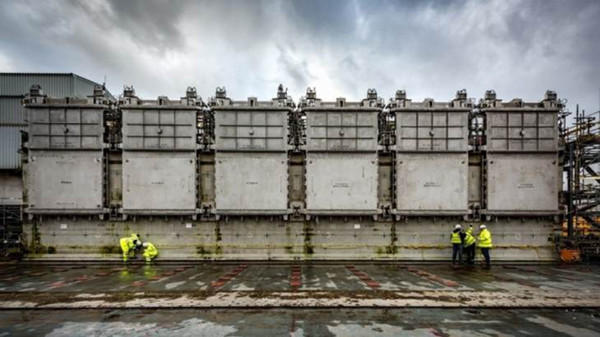Sellafield silo has waste retrieval equipment installed
Installation has been completed of the equipment needed to remove material from the Pile Fuel Cladding Silo (PFCS) at the Sellafield site in the UK. Demonstration removal of waste is scheduled for later this year, with larger scale removal operations set to start in 2020.

The six steel doors on the Pile Fuel Cladding Silo (Image: Sellafield Ltd)
The equipment is contained in nine metal modules. These fit together in a way that safely removes solid radioactive waste from the 18-metre high 'locked vault', which was originally designed to be permanently sealed.
Kevin Brown, head of the PFCS programme at Sellafield Ltd, said: "The teams are incredibly proud to have completed one of the most complex challenges in the site's history. We have opened up a building designed to be sealed forever and engineered a way for getting the waste out. After years of intensive planning, preparation and investment, seeing the retrievals modules in place next to the Pile Fuel Cladding Silo is a huge moment for those involved."
The modules were manufactured and tested by Babcock at Rosyth in Scotland before being transported to Sellafield where a 500-tonne crane was used to lift them into position on a platform built 15 m above ground. The first of the modules - known as the waste container transfer area - was lifted into place adjacent to compartment five, where the first retrieval is due to take place.
Six 12.4-tonne stainless steel doors have been fitted into a 40-tonne, nine-metre wide steel door frame on the side of the building. These doors, designed to open the building's 'locked vaults', will be the access point for waste retrieval machinery to begin safely lifting out the silo's contents.
To remove the waste, a crane will extend through the hole in the side of the silo, a grabber will be lowered to scoop up the waste, and the grabber then lifts and retreats back through the hole before depositing the waste in a specially-designed metal box. These boxes will then be used to store the waste in a facility currently under construction at the site.
The work is being carried out in collaboration with US-UK joint venture Bechtel Cavendish Nuclear Solutions.
"Our collaboration with Bechtel and Sellafield Ltd on a project of a strategic national importance is set to give Sellafield the tools it needs to accelerate hazard reduction at the site," said Paul Smith, managing director of nuclear services at Cavendish Nuclear.
Built between 1950 and 1951 the Pile Fuel Cladding Silo is 21 m high and, inside, houses six extremely tall waste containers. By the mid-1990s, the silo was nearing the end of its intended life. And, like any building exposed to the weather for 50 years, it required care and maintenance. A programme of upgrade work was completed to enable the building to continue to store waste safely, prior to the next task in the programme: to safely retrieve the waste and store it in compact concealed units. The PFCS holds over 3200 cubic metres of intermediate-level waste.
The silo contains cladding materials removed from fuel assemblies used in some of the UK's earliest reactors at Windscale and Chapelcross. Irradiated cladding had to be removed before used fuel assemblies could be reprocessed to recover the uranium and plutonium they contained for the purposes of the joint power and weapons nuclear programme run by the UK in the 1950s and 1960s.
- China Institute of Atomic Energy
- Nuclear Power Institute of China
- Southwestern Institute of Physics
- China Nuclear Power Operation Technology Corporation, Ltd.
- China Nuclear Power Engineering Co., Ltd.
- China Institute for Radiation Protection
- Beijing Research Institute of Uranium Geology (BRIUG)
- China Institute of Nuclear Industry Strategy (CINIS)
- China Nuclear Mining Science and Technology Corporation


